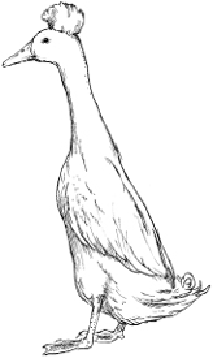Agriculture Reference
In-Depth Information
the protein ratio at this time and increasing the plant material so that they do not develop
angel wing (see
chapter 13
,
Waterfowl) and destroy their show quality. This is especially
crucial for geese. They need that green, fresh material to develop the proper bone struc-
ture to hold up their wing feathers. Remember, geese and ducks love to forage and eat
green things and confinement just does not do their physiology any justice.
A Bali can make an exemplary show duck.
Geese usually need 12 to 16 weeks to grow into a decent show specimen, but they
can be exhibited at an earlier age if you are unable to get them in time. Ducks can reach
maturity for show status in about 8 to 12 weeks, depending upon the breed. They aren't
as heavy as they will be later, but they're usually in proper form and ready to show.
Ducks younger than 8 weeks typically don't have their full set of feathers yet and do not
possess an appealing look.
Turkeys
Turkeys are a bit of a challenge for the 4-H exhibitor because they're not available until
late March or April generally, and so usually aren't big enough to show at a midsummer
fair, even if they are fully feathered and of a respectable weight for their age. Commer-
cial white turkeys, which grow at a rather rapid rate, may be ready to show, but heritage
types hatched in March or April do not grow fast enough and generally are not large
enough to show at a July show.
If you can successfully locate heritage turkeys born of an earlier hatch, you'll find
that they make excellent show specimens. They usually need to be about five months

